The Olivine Horizon of the Layered Monchegorsk Pluton (Kola Region, Russia): Additional Magma Injection Based on Integrated Geological and Geochronological Data
Abstract
:1. Introduction
2. Regional Geology
3. Geological Setting
3.1. Geology of the Paleoproterozoic Layered Monchepluton and Intrusions of Its Framing
3.2. Olivine Horizon
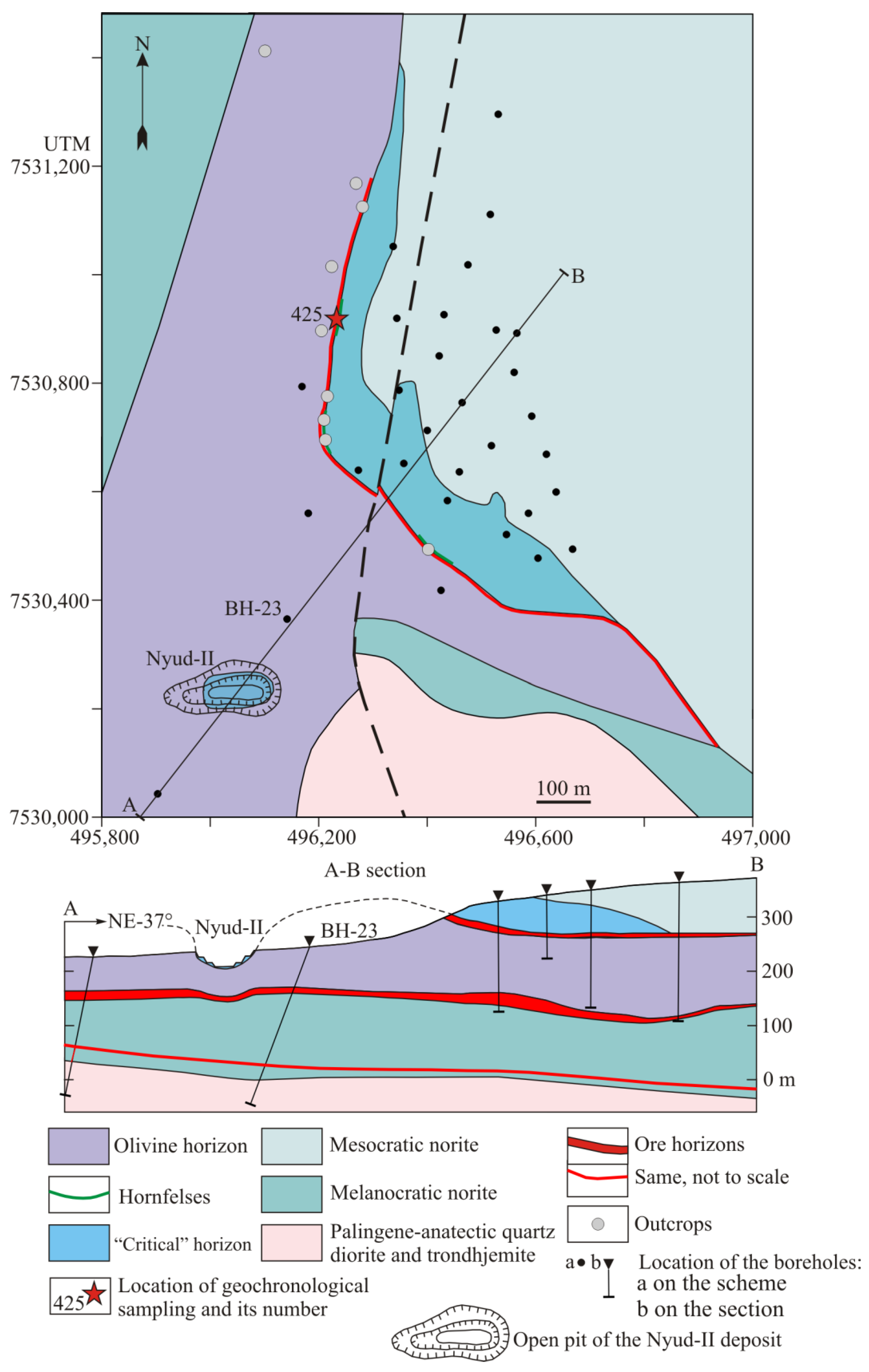
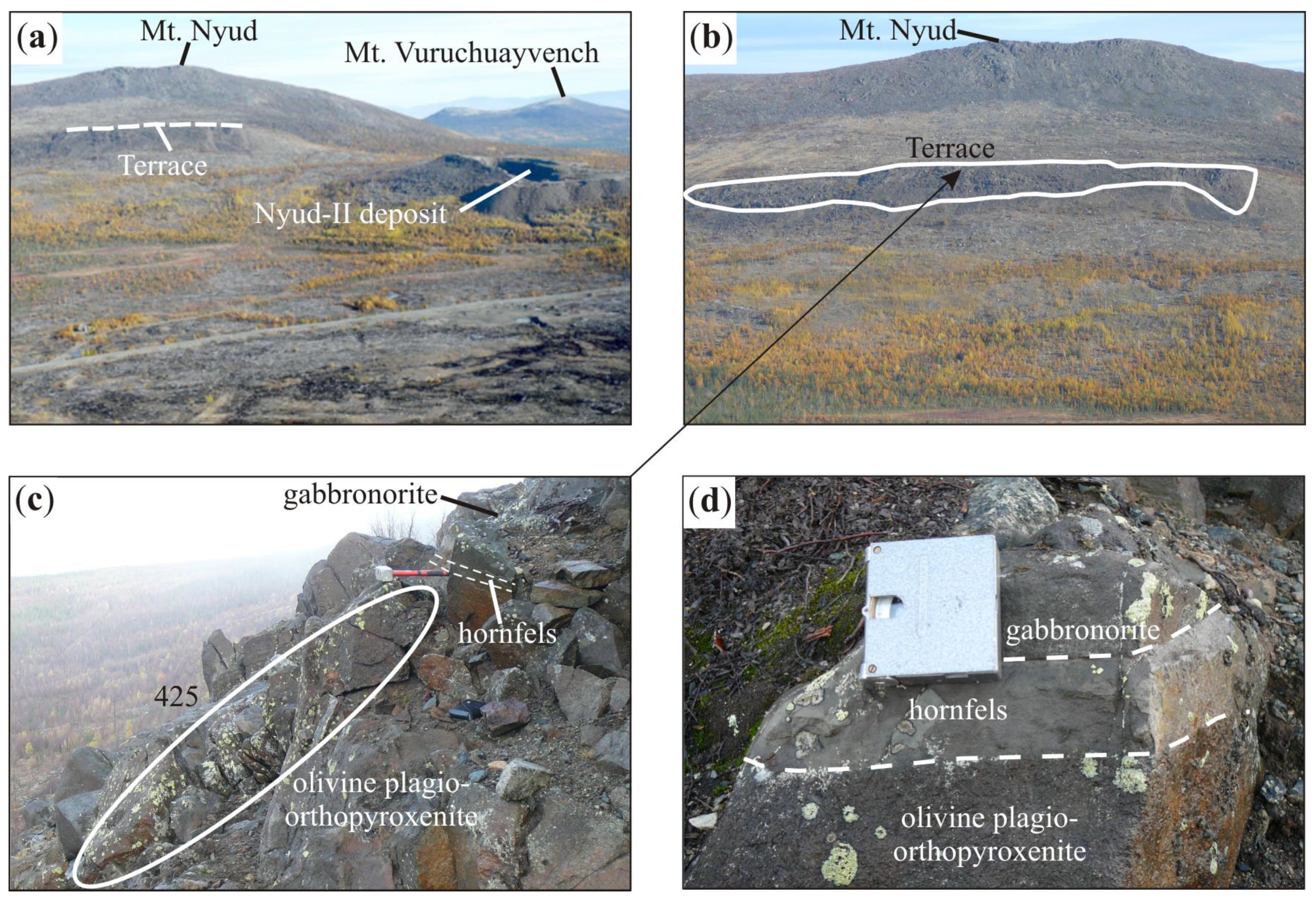
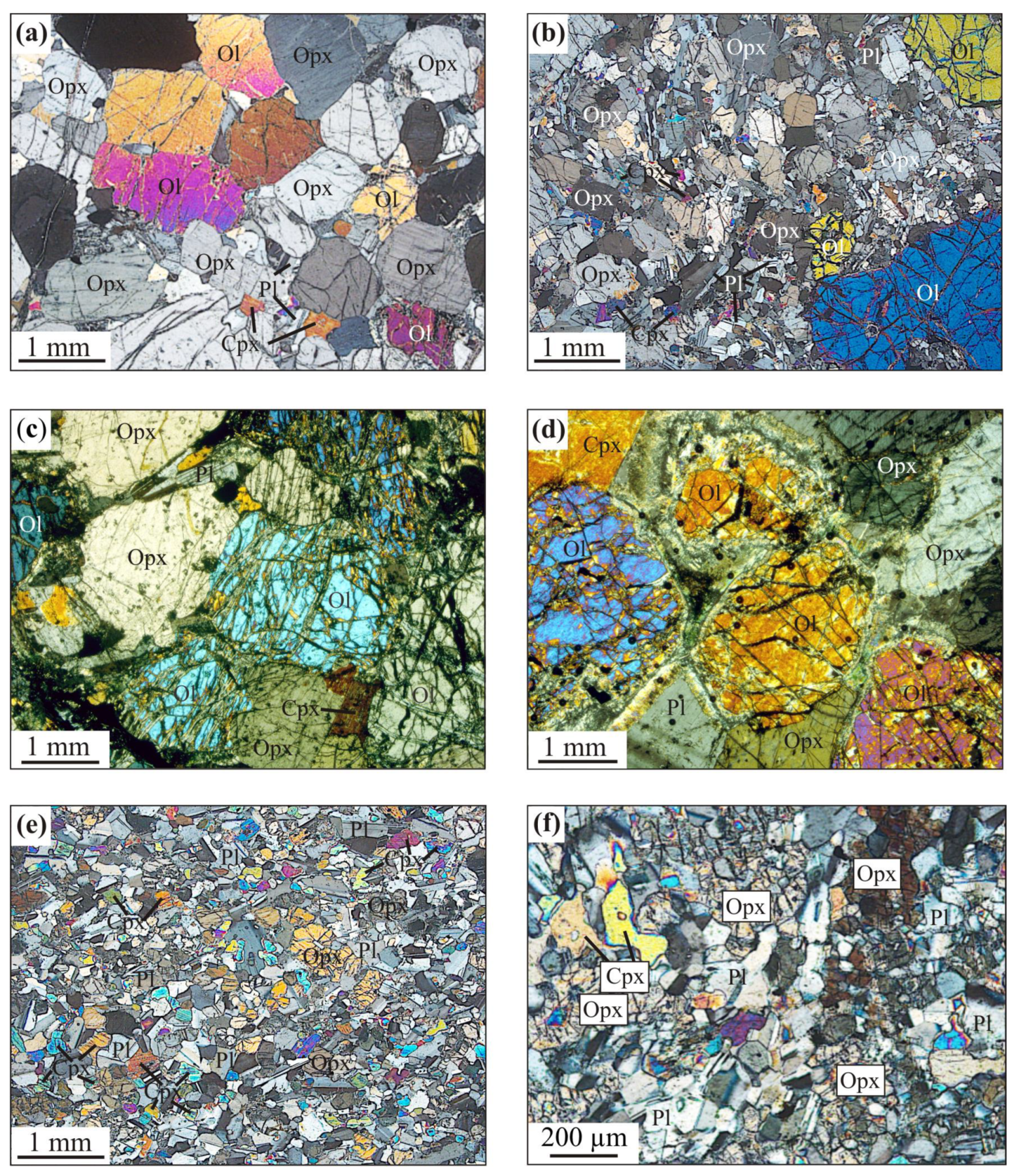
4. Materials and Methods
5. Results
6. Discussion
6.1. Geological Features of the Olivine Horizon
6.2. Zircon Morphology and U, and Th Contents
6.3. Geochronology and Formation Model of the Olivine Horizon
7. Conclusions
Supplementary Materials
Author Contributions
Funding
Data Availability Statement
Acknowledgments
Conflicts of Interest
References
- Kozlov, E.K. Rocks Natural Series of Nickel-Bearing Intrusions and Their Metallogeny; Nauka: Leningrad, Russia, 1973. (In Russian) [Google Scholar]
- Smolkin, V.F.; Fedotov, Z.A.; Orsoev, D.A.; Ohnenstetter, D. Ore-bearing layered Monchepluton. In Layered Intrusion of the Monchegorsk Ore Region: Petrology, Mineralization, Isotopy, Deep Structure. Part 1; Part 1, Mitrofanov, F.P., Smolkin, V.F., Eds.; Kola Science Center Russian Academy of Sciences: Apatity, Russia, 2004; pp. 36–74, (In Russian with English Abstract). [Google Scholar]
- Chashchin, V.V.; Ivanchenko, V.N. Sulfide PGE-Cu-Ni and low-sulfide Pt-Pd ores of the Monchegorsk ore district (Arctic Western Sector): Geology, mineralogy, geochemistry, and genesis. Russ. Geol. Geophys. 2022, 63, 519–542. [Google Scholar] [CrossRef]
- Eliseev, E.N. Disseminated sulfide mineralization of the Sopcha ore layer. In Ultrabasic and Basic Intrusions and sulfide Copper-Nickel Deposits of the Moncha; Eliseev, N.A., Ed.; USSR Academy of Sciences: Leningrad, Russia, 1953; pp. 112–143. (In Russian) [Google Scholar]
- Smolkin, V.F.; Kremenetsky, A.A.; Vetrin, V.R. Geological and genetic model of the formation of Paleoproterozoic ore-magmatic systems of the Baltic Shield. Otechestv. Geol. 2009, 54–62. (In Russian) [Google Scholar]
- Haughton, D.R.; Roeder, P.L.; Skinner, B.J. Solubility of sulfur in mafic magmas. Econ. Geol. 1974, 69, 451–467. [Google Scholar] [CrossRef]
- Cameron, E.N. Evolution of the Lower Critical zone, central sector, eastern Bushveld Complex, and its chromite deposits. Econ. Geol. 1980, 75, 845–871. [Google Scholar] [CrossRef]
- Campbell, I.H.; Naldrett, A.J.; Barnes, S.J. A model for the origin of the platinum-rich sulfide horizons in the Bushveld and Stillwater Complexes. J. Petrol. 1983, 24, 133–165. [Google Scholar] [CrossRef]
- Lee, C.A.; Butcher, A.R. Cyclicity in the Sr isotope stratigraphy through the Merensky and Bastard Reef units, Atok section, eastern Bushveld Complex. Econ. Geol. 1990, 85, 877–883. [Google Scholar] [CrossRef]
- Cawthorn, R.G. Pressure fluctuations and the formation of the PGErich Merensky and chromitite reefs, Bushveld Complex. Miner. Depos. 2005, 40, 231–235. [Google Scholar] [CrossRef]
- Maier, W.D.; Barnes, S.-J.; Groves, D.I. The Bushveld Complex, South Africa: Formation of platinum-palladium, chrome- and vanadiumrich layers via hydrodynamic sorting of a mobilized cumulate slurry in a large, relatively slowly cooling, subsiding magma chamber. Miner. Depos. 2013, 48, 1–56. [Google Scholar] [CrossRef]
- Scoates, J.S.; Wall, C.J.; Friedman, R.M.; Weis, D.; Mathez, E.A.; VanTongeren, J.A. Dating the Bushveld Complex: Timing of crystallization, duration of magmatism, and cooling of the world’s largest layered intrusion and related rocks. J. Petrol. 2021, 62, egaa107. [Google Scholar] [CrossRef]
- Kozlov, N.E.; Sorokhtin, N.O.; Glaznev, V.N.; Kozlova, N.E.; Ivanov, A.A.; Kudryashov, N.M.; Martynov, E.V.; Tyuremnov, V.V.; Matyushkin, A.V.; Osipenko, L.G. Geology of the Archean Baltic Shield; Nauka: Saint Petersburg, Russia, 2006. (In Russian) [Google Scholar]
- Slabunov, A.I.; Balagansky, V.V.; Shchipansky, A.A. Mesoarchean to Paleoproterozoic crustal evolution of the Belomorian province, Fennoscandian Shield, and the tectonic setting of eclogites. Russ. Geol. Geophys. 2021, 62, 525–546. [Google Scholar] [CrossRef]
- Gaál, G.; Gorbatschev, R. An outline of the Precambrian evolution of the Baltic shield. Precambrian Res. 1987, 35, 15–52. [Google Scholar] [CrossRef]
- Balagansky, V.V.; Gorbunov, I.A.; Mudruk, S.V. Paleoproterozoic Lapland–Kola and Svecofennian orogens (Baltic Shield). Vestn. KNTs RAN 2016, 3, 5–11, (In Russian with English Abstract). [Google Scholar]
- Amelin, Y.V.; Heaman, L.M.; Semenov, V.S. U-Pb geochronology of layered mafic intrusions in the eastern Baltic Shield: Implication for the timing and duration of Paleoproterozoic continental rifting. Precambrian Res. 1995, 75, 31–46. [Google Scholar] [CrossRef]
- Lahtinen, R.; Garde, A.A.; Melezhik, V.A. Paleoproterozoic evolution of Fennoscandia and Greenland. Episodes 2008, 31, 20–28. [Google Scholar] [CrossRef] [PubMed]
- Puchtel, I.S.; Haase, K.M.; Hofmann, A.W.; Chauvel, C.; Kulikov, V.S.; Garbe-Schönberg, C.-D.; Nemchin, A.A. Petrology and geochemistry of crustally contaminated komatiitic basalts from the Vetreny belt, southeastern Baltic Shield: Evidence for an early Proterozoic mantle plume beneath rifted Archean continental lithosphere. Geochim. Cosmochim. Acta 1997, 61, 1205–1222. [Google Scholar] [CrossRef]
- Sharkov, E.V.; Bogatikov, O.A.; Krasivskaya, I.S. The role of mantle plumes in the early Precambrian tectonics of the eastern Baltic Shield. Geotectonics 2000, 34, 85–105. [Google Scholar]
- Yang, S.-H.; Hanski, E.; Li, C.; Maier, W.D.; Huhma, H.; Mokrushin, A.V.; Latypov, R.; Lahaye, Y.; O’Brien, H.; Qu, W.-J. Mantle source of the 2.44–2.50-Ga mantle plume-related magmatism in the Fennoscandian Shield: Evidence from Os, Nd, and Sr isotope compositions of the Monchepluton and Kemi intrusions. Miner. Depos. 2016, 51, 1055–1073. [Google Scholar] [CrossRef]
- Balashov, Y.A.; Bayanova, T.B.; Mitrofanov, F.P. Isotope data on the age and genesis of layered basic-ultrabasic intrusions in the Kola Peninsula and northern Karelia, northeastern Baltic Shield. Precambrian Res. 1993, 64, 197–205. [Google Scholar] [CrossRef]
- Bayanova, T.B. Age of the Reverence Geological Complexes of the Kola Region and Duration of Magmatic Processes; Nauka: Saint Petersburg, Russia, 2004. (In Russian) [Google Scholar]
- Chashchin, V.V. Paleoproterozoic complex of layered intrusions of the Kola Peninsula and its metallogeny (Russia). Geol. Ore Depos. 1999, 41, 114–125. [Google Scholar]
- Alapieti, T.T.; Filen, B.A.; Lahtinen, J.J.; Lavrov, V.V.; Smolkin, V.F.; Voitsekhovsky, S.N. Early Proterozoic layered intrusions in the northeastern part of the Fennoscandian Shield. Mineral. Petrol. 1990, 42, 1–22. [Google Scholar] [CrossRef]
- Alapieti, T.T.; Lahtinen, J.J. Platinum-group element mineralization in layered intrusions of northern Finland and the Kola Peninsula, Russia. In The Geology, Geochemistry, Mineralogy and Mineral Benefication of Platinum-Group Elements; Cabri, L.J., Ed.; Canadian Institute of Mining, Metallurgy and Petroleum: Ottawa, ON, Canada, 2002; Volume 54, pp. 507–546. [Google Scholar] [CrossRef]
- Maier, W.D. Geology and petrogenesis of magmatic Ni-Cu-PGE-Cr-V deposits: An introduction and overview. In Mineral Deposits of Finland; Maier, W.D., Lahtinen, R., O’Brien, H., Eds.; Elsevier: Amsterdam, The Netherlands; Oxford, UK; Waltham, MA, USA, 2015; pp. 73–92. [Google Scholar] [CrossRef]
- Sharkov, E.V.; Krasivskaya, I.S.; Chistyakov, A.V. Dispersed mafic–ultramafic intrusive magmatism in Early Paleoproterozoic mobile zones of the Baltic Shield: An example of the Belomorian drusite (coronite) complex. Petrology 2004, 12, 561–582. [Google Scholar]
- Krivolutskaya, N.A.; Svirskaya, N.M.; Roshchina, I.A.; Smolkin, V.F.; Mamontov, V.P.; Fanygin, A.S.; Belyatskii, B.V. Geochemical features of the drusite massifs, the central part of the Belomorian mobile belt: I. Distribution of major and trace elements in the rocks. Geochem. Int. 2010, 48, 465–491. [Google Scholar] [CrossRef]
- Chashchin, V.V.; Galkin, A.S.; Ozeryanskii, V.V.; Dedyukhin, A.N. Sopcha Lake chromite deposit and its platinum potential, Monchegorsk Pluton, Kola Peninsula (Russia). Geol. Ore Depos. 1999, 41, 460–468. [Google Scholar]
- Mokrushin, A.V.; Smolkin, V.F. Chromite mineralization in the Sopcheozero deposit (Monchegorsk layered intrusion, Fennoscandian Shield). Minerals 2021, 11, 772. [Google Scholar] [CrossRef]
- Alapieti, T.T.; Kujanpää, J.; Lahtinen, J.J.; Papunen, H. The Kemi stratiform chromitite deposit, northern Finland. Econ. Geol. 1989, 84, 1057–1077. [Google Scholar] [CrossRef]
- Fedotov, Z.A.; Smolkin, V.F.; Mokrushin, A.V. The Umbarechka-Umba chromite-bearing norite-gabbronorite complex. In Layered Intrusion of the Monchegorsk Ore Region: Petrology, Mineralization, Isotopy, Deep Structure. Part 1; Mitrofanov, F.P., Smolkin, V.F., Eds.; Kola Science Center Russian Academy of Sciences: Apatity, Russia, 2004; pp. 98–116, (In Russian with English Abstract). [Google Scholar]
- Groshev, N.Y.; Rundkvist, T.V.; Karykowski, B.T.; Maier, W.D.; Korchagin, A.U.; Ivanov, A.N.; Junge, M. Low-sulfide platinum-palladium deposits of the Paleoproterozoic Fedorova-Pana layered complex, Kola Region, Russia. Minerals 2019, 9, 764. [Google Scholar] [CrossRef]
- Iljina, M.; Maier, W.D.; Karinen, T. PGE-(Cu-Ni) deposits of the Tornio-Näränkävaara belt of intrusions (Portimo, Penikat, and Koillismaa). In Mineral Deposits of Finland; Maier, W.D., Lahtinen, R., O’Brien, H., Eds.; Elsevier: Amsterdam, The Netherlands; Oxford, UK; Waltham, MA, USA, 2015; pp. 133–164. [Google Scholar] [CrossRef]
- Huhtelen, T. The Kemi chromite deposit. In Mineral Deposits of Finland; Maier, W.D., Lahtinen, R., O’Brien, H., Eds.; Elsevier: Amsterdam, The Netherlands; Oxford, UK; Waltham, MA, USA, 2015; pp. 165–178. [Google Scholar] [CrossRef]
- Karinen, T.; Hanski, E.; Taipale, A. Mustavaara V-Fe-Ti oxide deposit. In Mineral Deposits of Finland; Maier, W.D., Lahtinen, R., O’Brien, H., Eds.; Elsevier: Amsterdam, The Netherlands; Oxford, UK; Waltham, MA, USA, 2015; pp. 179–195. [Google Scholar] [CrossRef]
- Gorbunov, G.I.; Yakovlev, Y.N.; Goncharov, Y.V.; Gorelov, V.A.; Telnov, V.A. Kola Peninsula nickel-bearing regions. In Baltic Shield Copper–Nickel Deposits; Gorbunov, G.I., Papunen, H., Eds.; Nauka: Leningrad, Russia, 1985; pp. 27–93. (In Russian) [Google Scholar]
- Chashchin, V.V.; Bayanova, T.B. Sopcheozero chromite deposit: Geochemistry and U-Pb age. Proc. Fersman Sci. Sess. Geol. Inst. KSC RAS 2021, 18, 403–408. [Google Scholar] [CrossRef]
- Chashchin, V.V.; Bayanova, T.B. Cumulus stratigraphy, petrochemistry, and U-Pb age of the layered Poaz intrusion of Monchegorsk pluton, Kola Peninsula. In Proceedings of the Fersman Scientific Session of the Geological Institute of the Kola Science of the Russian Academy of Sciences, Apatity, Russia, 5–6 April 2023; pp. 229–235, (In Russian with English Abstract). [Google Scholar]
- Rundkvist, T.V.; Bayanova, T.B.; Sergeev, S.A.; Pripachkin, P.V.; Grebnev, R.A. The Paleoproterozoic Vurechuaivench layered Pt-bearing pluton, Kola Peninsula: New results of the U-Pb (ID TIMS, SHRIMP) dating of baddeleyite and zircon. Dokl. Earth Sci. 2014, 454, 1–6. [Google Scholar] [CrossRef]
- Chashchin, V.V.; Bayanova, T.B.; Levkovich, N.V. Volcanoplutonic association of the early-stage evolution of the Imandra-Varzuga rift zone, Kola Peninsula, Russia: Geological, petrogeochemical, and isotope-geochronological data. Petrology 2008, 16, 279–298. [Google Scholar] [CrossRef]
- Vrevsky, A.B. Petrology, age, and polychromous sources of the initial magmatism of the Imandra-Varzuga paleorift, Fennoscandian shield. Petrology 2011, 19, 521–547. [Google Scholar] [CrossRef]
- Chashchin, V.V.; Bayanova, T.B.; Savchenko, Y.E.; Kiseleva, D.V.; Serov, P.A. Petrogenesis and age of rocks from the lower zone of the Monchetundra mafic platinum-bearing massif, Kola Peninsula. Petrology 2020, 28, 151–182. [Google Scholar] [CrossRef]
- Chashchin, V.V.; Bayanova, T.B.; Mitrofanov, F.P.; Serov, P.A. Low-sulfide PGE oers in Paleoproterozoic Monchegorsk pluton and massifs of its southern framing, Kola Peninsula, Russia: Geological characteristic and isotopic geochronological evidence of polychromous ore-magmatic systems. Geol. Oer Depos. 2016, 58, 37–57. [Google Scholar] [CrossRef]
- Nerovich, L.I.; Bayanova, T.B.; Savchenko, Y.e.E.; Serov, P.A.; Ekimova, N.A. New data on geology, petrography, isotopic geochemistry, and PGE mineralization of the Monchetundra massif. Proc. Murm. State Tech. Univ. 2009, 12, 461–477, (In Russian with English Abstract). [Google Scholar]
- Bayanova, T.B.; Nerovich, L.I.; Mitrofanov, F.P.; Zhavkov, V.A.; Serov, P.A. The Monchetundra basic massif of the Kola Region: New geological and isotope geochronological data. Dokl. Earth Sci. 2010, 431, 288–293. [Google Scholar] [CrossRef]
- Mitrofanov, F.P.; Balagansky, V.V.; Balashov, Y.A.; Gannibal, L.F.; Dokuchaeva, V.S.; Nerovich, L.I.; Radchenko, M.K.; Ryungenen, G.I. U-Pb age of gabbro-anorthosites of the Kola Peninsula. Dokl. Earth Sci. 1993, 331, 95–98. (In Russian) [Google Scholar]
- Chashchin, V.V.; Bayanova, T.B.; Lyulko, M.S. Geologic composition and U–Pb age of the Kirikha gabbro-norite massif—Kola Peninsula, Russia. In Proceedings of the Geology and Geochronology of Rock-Forming and Ore Processes in Crystalline Shields. Proceedings of the All-Russian Conference, Apatity, Russia, 8–12 July 2013; pp. 179–181. (In Russian). [Google Scholar]
- Sharkov, E.V. “Critical horizon” of the Monchegorsk pluton—An additional intrusive phase. Proc. All-Union Mineral. Soc. 1982, 111, 656–664. (In Russian) [Google Scholar]
- Chashchin, V.V.; Petrov, S.V.; Kiseleva, D.S.; Savchenko, Y.E. Platinum content and formation conditions of the sulfide PGE-Cu-Ni Nyud-II deposit of the Monchegorsk pluton, Kola Peninsula, Russia. Geol. Ore Depos. 2021, 63, 87–117. [Google Scholar] [CrossRef]
- Warr, L.N. IMA-CNMNC approved mineral symbols. Mineral. Mag. 2021, 85, 291–320. [Google Scholar] [CrossRef]
- Williams, I.S. U–Th–Pb geochronology by ion microprobe. In Applications of Microanalytical Techniques to Understanding Mineralizing Processes; McKibben, M.A., Shanks, W.C., Ridley, W.I., Eds.; Reviews in Economic Geology; Economic Geology Pub Co.: Socorro, NM, USA; Toronto, ON, Canada, 1998; pp. 1–35. [Google Scholar]
- Schuth, S.; Gornyy, V.I.; Berndt, J.; Shevchenko, S.S.; Sergeev, S.A.; Karpuzov, A.F.; Mansfeldt, T. Early Proterozoic U-Pb Zircon Ages from Basement Gneiss at the Solovetsky Archipelago, White Sea, Russia. Int. J. Geosci. 2012, 3, 289–296. [Google Scholar] [CrossRef]
- Black, L.P.; Kamo, S.L.; Allen, C.M.; Aleinikoff, J.N.; Davis, D.W.; Korsch, R.J.; Foudoulis, C. TEMORA 1: A new zircon standard for U-Pb geochronology. Chem. Geol. 2003, 200, 155–170. [Google Scholar] [CrossRef]
- Wiedenbeck, M.; Alle, P.; Corfu, F.; Griffin, W.L.; Meier, M.; Oberli, F.; Von Quadt, A.; Roddick, J.C.; Spiegel, W. Three natural zircon standards for U-Th-Pb, Lu-Hf trace element and REE analyses. Geostand. Geoanalyt. Res. 1995, 19, 1–23. [Google Scholar] [CrossRef]
- Ludwig, K.R. SQUID 1.02, a User Manual, a Geochronological Toolkit for Microsoft Excel; Berkeley Geochronology Center Special Publication: Berkeley, CA, USA, 2001. [Google Scholar]
- Wetherill, G.W. Discordant uranium-lead ages. Trans. Am. Geophys. Union 1956, 37, 320–326. [Google Scholar]
- Ludwig, K.R. User’s Manual for Isoplot 3.00, a Geochronological Toolkit for Microsoft Excel; Berkeley Geochronology Centre Special Publication: Berkeley, CA, USA, 2003. [Google Scholar]
- Stacey, J.S.; Kramers, J.D. Approximation of terrestrial lead isotope evolution by a two-stage model. Earth Planet. Sci. Lett. 1975, 26, 207–221. [Google Scholar] [CrossRef]
- Nair, V.C.A. The instability of convection of magma in the chamber, trigging eruption in volcanoes. Int. Adv. Res. J. Sci. Engin. Technol. 2019, 6, 1–15. [Google Scholar] [CrossRef]
- Corfu, F.; Hanchar, J.M.; Hoskin, P.W.O.; Kinny, P. Atlas of zircon textures. Rev. Mineral. Geochem. 2003, 53, 468–500. [Google Scholar] [CrossRef]
- Hoskin, P.W.O.; Schaltegger, U. The composition of zircon and metamorphic petrogenesis. Rev. Mineral. Geochem. 2003, 53, 27–62. [Google Scholar] [CrossRef]
- Groshev, N.Y.; Pripachkin, P.V.; Malygina, A.V.; Karykowski, B.T.; Rodionov, N.V.; Belyatsky, B.V. Genesis of a magnetite layer in the Gabbro-10 intrusion, Monchegorsk Complex, Kola Region: U-Pb SHRIMP-II dating of metadiorites. Geol. Ore Depos. 2018, 60, 486–496. [Google Scholar] [CrossRef]
- Groshev, N.Y.; Nitkina, E.A.; Mitrofanov, F.P. Two-phase mechanism of the formation of platinum-metal basites of the Fedorova Tundra intrusion of the Kola Peninsula: New data on geology and isotope geochronology. Dokl. Earth Sci. 2009, 427, 1012–1016. [Google Scholar] [CrossRef]
- Nitkina, E.A. U-Pb zircon dating of rocks of the platiniferous Fedorova-Pana layered massif, Kola Peninsula. Dokl. Earth Sci. 2006, 408, 551–554. [Google Scholar] [CrossRef]
- Chashchin, V.V.; Bayanova, T.B.; Levkovich, N.V. The Kislaya Guba formation of the Late Archean Terskii-Allarechensk greenstone belt (Kola Peninsula, Russia): Stratotype and U-Pb age. Stratigr. Geol. Correl. 2004, 12, 541–552. [Google Scholar]

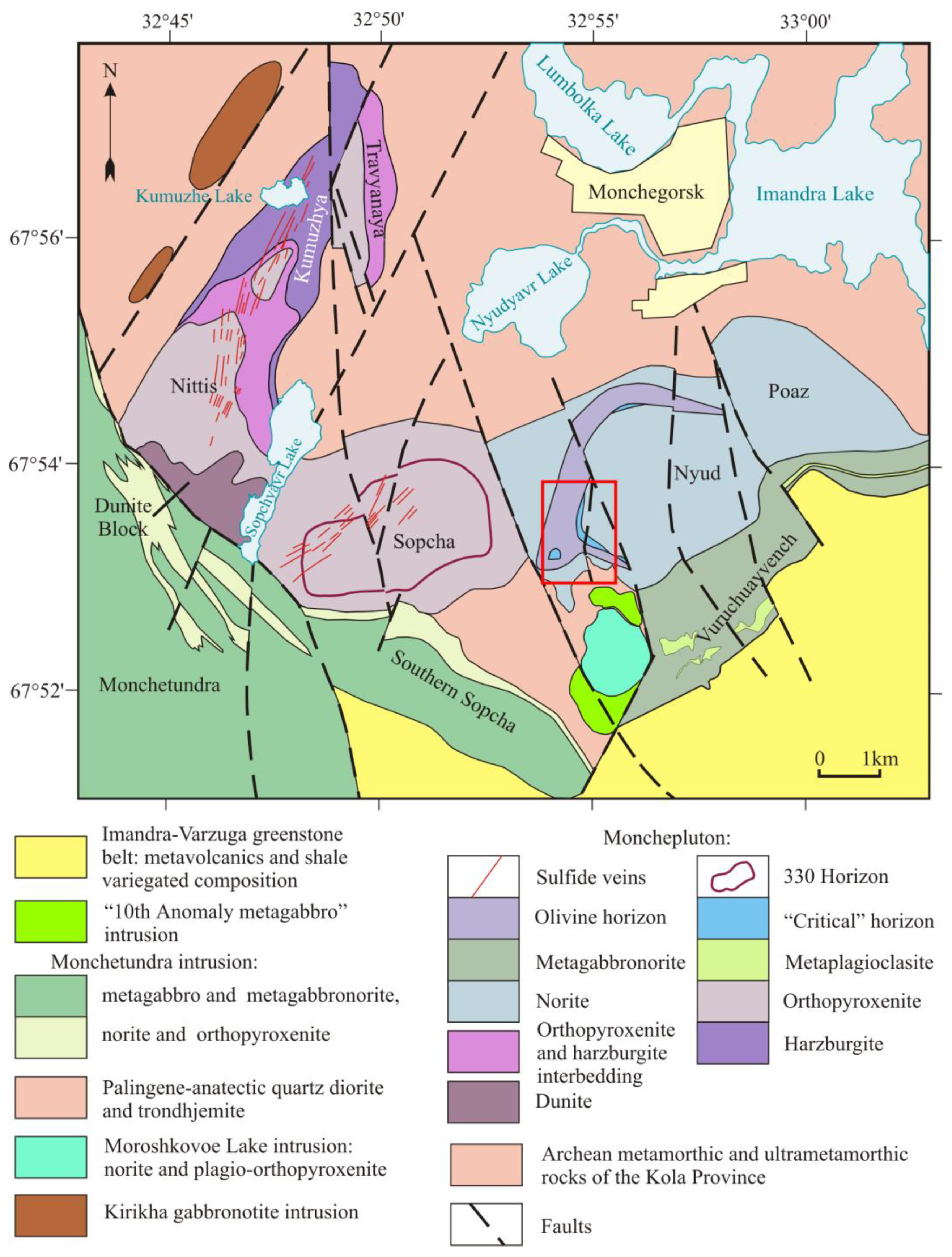
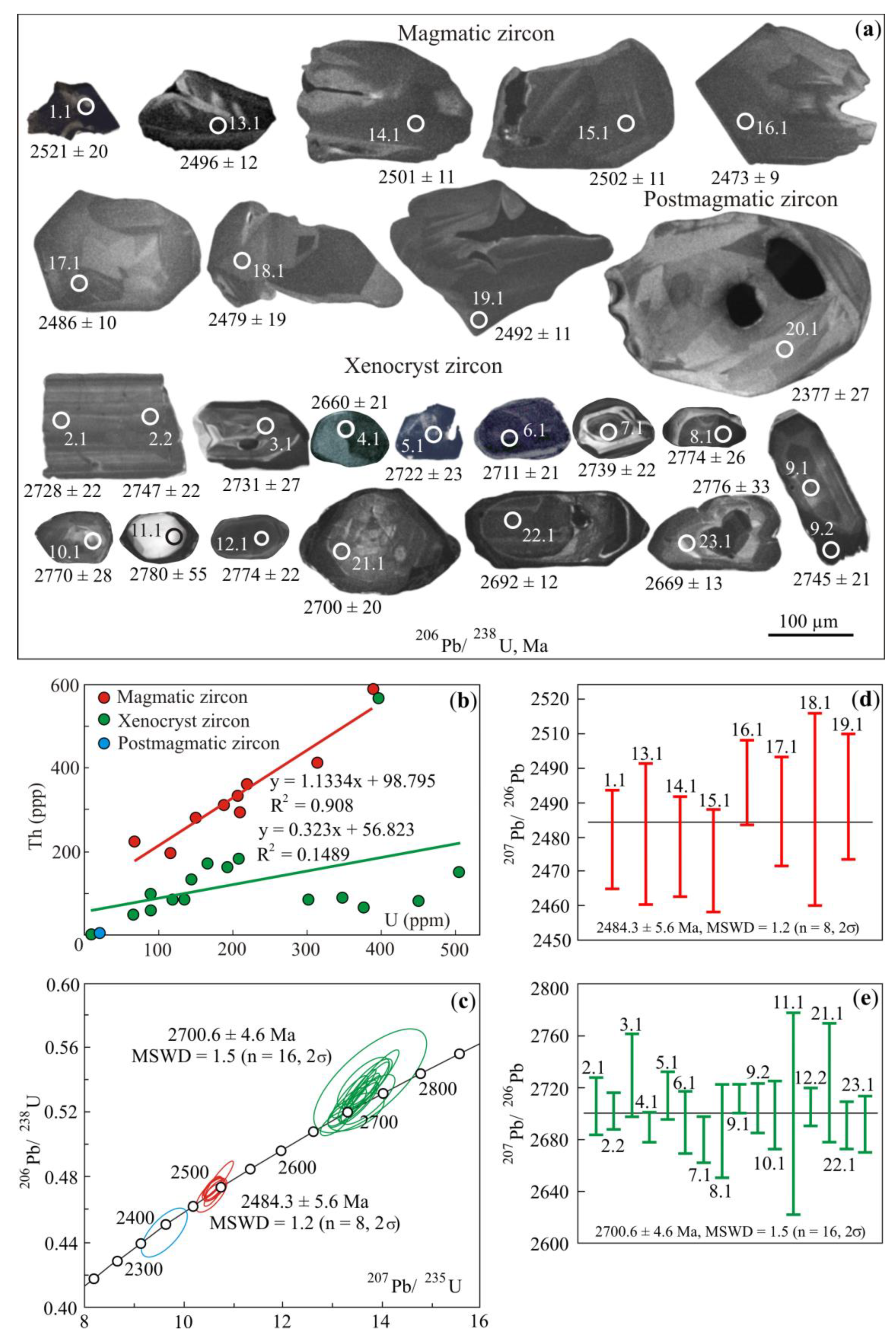
Disclaimer/Publisher’s Note: The statements, opinions and data contained in all publications are solely those of the individual author(s) and contributor(s) and not of MDPI and/or the editor(s). MDPI and/or the editor(s) disclaim responsibility for any injury to people or property resulting from any ideas, methods, instructions or products referred to in the content. |
© 2023 by the authors. Licensee MDPI, Basel, Switzerland. This article is an open access article distributed under the terms and conditions of the Creative Commons Attribution (CC BY) license (https://creativecommons.org/licenses/by/4.0/).
Share and Cite
Chashchin, V.; Sergeev, S. The Olivine Horizon of the Layered Monchegorsk Pluton (Kola Region, Russia): Additional Magma Injection Based on Integrated Geological and Geochronological Data. Geosciences 2023, 13, 344. https://doi.org/10.3390/geosciences13110344
Chashchin V, Sergeev S. The Olivine Horizon of the Layered Monchegorsk Pluton (Kola Region, Russia): Additional Magma Injection Based on Integrated Geological and Geochronological Data. Geosciences. 2023; 13(11):344. https://doi.org/10.3390/geosciences13110344
Chicago/Turabian StyleChashchin, Victor, and Sergey Sergeev. 2023. "The Olivine Horizon of the Layered Monchegorsk Pluton (Kola Region, Russia): Additional Magma Injection Based on Integrated Geological and Geochronological Data" Geosciences 13, no. 11: 344. https://doi.org/10.3390/geosciences13110344
APA StyleChashchin, V., & Sergeev, S. (2023). The Olivine Horizon of the Layered Monchegorsk Pluton (Kola Region, Russia): Additional Magma Injection Based on Integrated Geological and Geochronological Data. Geosciences, 13(11), 344. https://doi.org/10.3390/geosciences13110344






